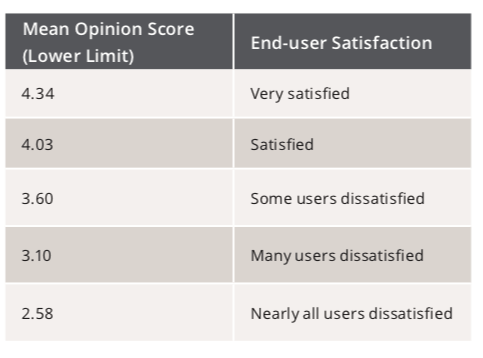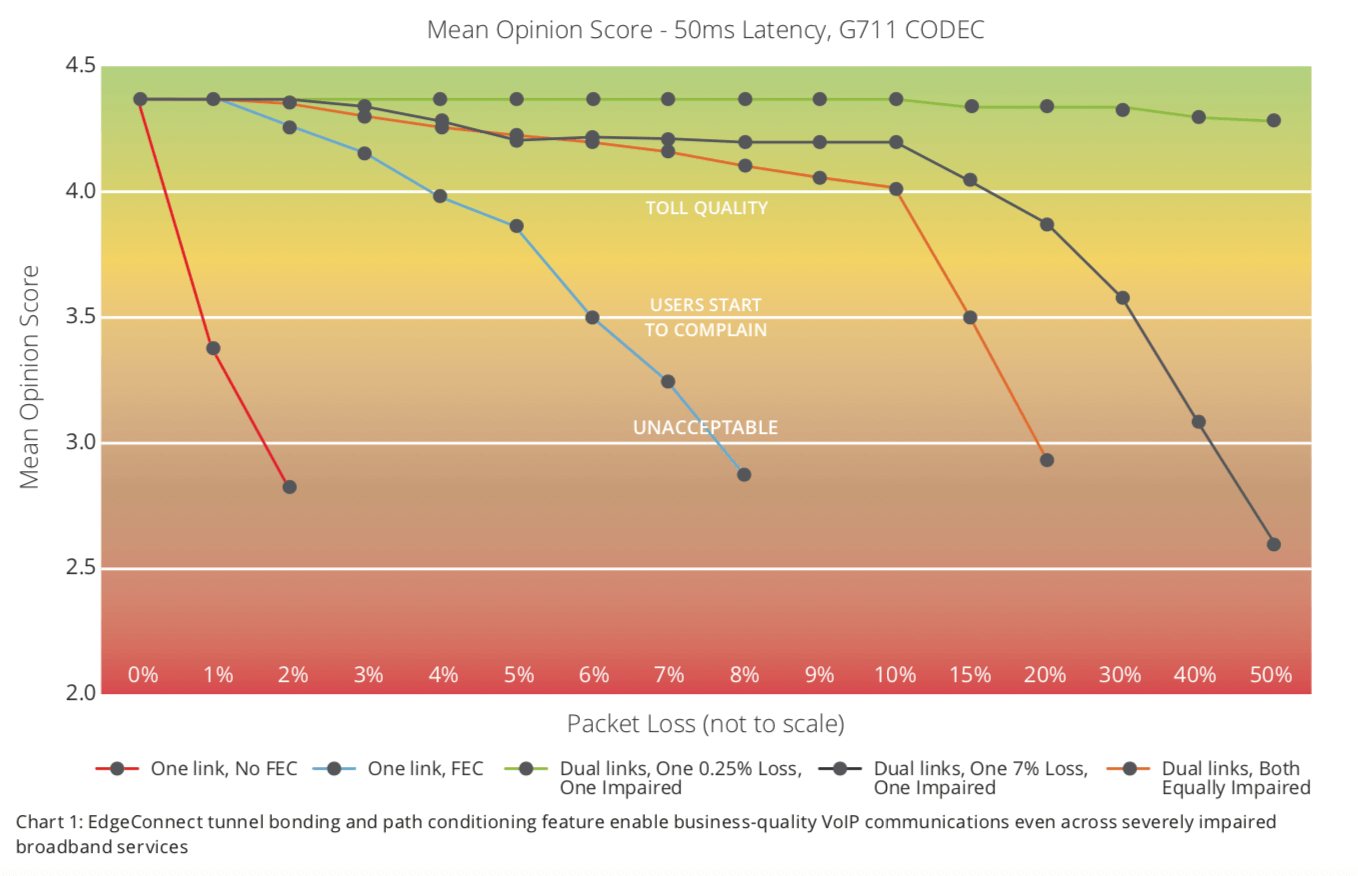Unity EdgeConnectTM Nets Exceptional Mean Opinion Scores for Voice Quality over the Internet; Producing Very Satisfied Branch Office Workers
When it comes to finalizing an important business contract, communicating key information to employees, handling a dissatisfied customer or innumerable other use cases, there is no substitute for real-time voice and video communications. An email or prerecorded message simply isn’t acceptable, even for a geographically distributed enterprise.
New Unified Communications (UC) solutions make it easier for IT to deploy and implement a rich suite of communications and collaboration functions by consolidating real-time voice telephony, video conferencing, instant messaging and non-real-time communications in a single service. But they have to work reliably for all users, all the time, from wherever they are working.
How often have we tried to participate in an unintelligible, garbled Voice over IP (VoIP) call or frustratingly tried to watch a pixelated video conferencing screen, often having to re-initiate the call? And when user experience deteriorates enough, it results in a flood of calls to the IT help desk. As active use of broadband connectivity increases with SD-WAN, the SD-WAN solution carrying real-time traffic must include capabilities to overcome the effects of packet loss, latency and jitter that degrade voice quality. This solution brief outlines how an advanced SD-WAN solution, such as Silver Peak® Unity EdgeConnect, can reliably deliver high-quality voice communications over broadband services, enabling geographically distributed organizations to realize the full potential of their SD-WAN deployments.
How often have we tried to participate in an unintelligible, garbled Voice over IP (VoIP) call or frustratingly tried to watch a pixelated video conferencing screen, often having to re-initiate the call?
How an Advanced SD-WAN Solution Can Maintain Voice Quality

A commonly used metric that describes voice call quality is the Mean Opinion Score (MOS). MOS measurements range from one to five with five representing pristine audio quality, as if the speakers were face-to-face in a quiet, sealed room. Toll-quality calls have a typical MOS ranging from 4.0 to 4.35. Users begin to complain when the MOS falls below 3.7, and scores below 3.0 are generally considered unacceptable for business communications. See Table 1, reproduced from the G.107 standard, for a correlation of user satisfaction and MOS for a voice call.
An actual MOS is a qualitative estimate, made by a human being experiencing a voice call, hence the word “opinion.” In practice, there are common algorithms used to estimate a MOS based on a number of factors including the amount of packet loss, latency and jitter that occur in the underlying WAN transport. Broadband services, and especially consumer broadband, usually experience higher levels of all three of these factors than do private leased line services such as MPLS. This creates a challenge to delivering an acceptable MOS. Fortunately, EdgeConnect incorporates sophisticated performance features to overcome the effects of packet loss, latency and jitter. As a result, organizations deploying an EdgeConnect SD-WAN solution can deliver exceptional voice call quality to their employees and customers, even when underlying WAN transport services are impaired due to congestion or other reasons.
Silver Peak EdgeConnect Scores with Exceptional Voice MOS
Silver Peak recently conducted a battery of tests to demonstrate how EdgeConnect can deliver toll-quality or near toll-quality voice calls, even under severe packet loss and latency conditions. For the tests, we configured two locations connected via two bi-directional 100 Mbps transport links. We set up twelve bi-directional VoIP calls and added background data traffic to simulate a real-world WAN environment.
We employed the EdgeConnect High Availability (HA) tunnel bonding policy, which sends data traffic down one link and forward error correction (FEC) packets down the second. FEC and packet order correction (POC), collectively called “path conditioning”, corrects for lost or out-of-order packets to deliver superior quality at the application layer, in this case, the VoIP call.
An added benefit of the HA mode is instantaneous failover – without any discernible interruption to a voice call – should one service experience a complete outage. For a more detailed discussion of EdgeConnect business intent overlays, tunnel bonding, path conditioning and rate shaping, refer to the Solution Brief, “Not All SD-WANs are Created Equal: Performance Matters.”
For these tests, we used the Ixia performance monitoring product called “Hawkeye.” Hawkeye, as described on the Ixia website, leverages synthetic traffic monitoring to perform node-to-node and real service testing to determine the end user experience. In our tests, Hawkeye was used as a traffic generator and tester to simulate the broadband transport services, initiate VoIP calls, generate background traffic, introduce packet loss to one or both transport services and to measure and report the MOS. Hawkeye uses a modified version of the ITU G.107 standard E-Model equation to calculate MOS for each endpoint pair. We terminated every test case when the MOS fell below 2.99 since any phone call with a MOS less than 3 is considered unacceptable for business communications.
EdgeConnect MOS test case parameters for all test scenarios:
- 12 simultaneous, bi-directional calls
- Voice call bandwidth 768kbps per direction
- G.711 CODEC
- 50ms latency for all test cases
- Dual-link tests run with HA bonding policy
- Nominal 0.25% packet loss on unimpaired links
- Tests terminated when MOS < 2.99
Test Scenario #1: Baseline voice performance across a single broadband service
To create a baseline, we ran our test case across a single emulated broadband service with 0.25 percent packet loss and 50ms of latency. This test case demonstrates the expected performance of running VoIP across a single broadband service that is performing well. For the initial test, we did not turn on the FEC/POC path conditioning features. As you can see in Chart 1 below, unacceptable voice quality resulted with only 1.75 percent packet loss.
We then turned on the EdgeConnect FEC and POC features, which still operated over a single link. With path conditioning, EdgeConnect sustained a business-level MOS greater than 3.0 across a single broadband link experiencing nearly 8 percent packet loss.
Test Scenario #2: Two broadband services with one link impaired
In this test scenario, we provisioned two broadband services and employed the EdgeConnect HA tunnel bonding policy to correct for dropped packets. In this scenario, we sustained greater than 50 percent packet loss over a single link with very little degradation of MOS, maintaining a better than toll-quality voice experience. This is as expected since one link was virtually unimpaired with just 0.25 percent packet loss programmed for the test.

To test asymmetrical loss patterns and further stress the ability to overcome the effects of packet loss, we performed a second variation of this test. In this variant, we increased the packet loss on the “better” link to 5 and 7 percent. With 5 percent loss on the better link, we achieved a MOS of 3.04 with 50 percent loss in the impaired link (not shown in Chart 1 below). Increasing loss further, with 7 percent loss on the better link, a business-quality MOS greater than 3.0 was still achieved with loss exceeding 40 percent on the impaired link as shown in Chart 1. Many basic internet applications, such as email, begin to fail due to performance degradation when packet loss exceeds just 5 percent.
With the EdgeConnect HA tunnel bonding policy enabled, it does not matter which connection experiences high packet loss. EdgeConnect automatically adapts and corrects for packet loss to deliver pristine voice quality.
Test Scenario #3: Two broadband services, both impaired
The third scenario tests the condition where both underlying broadband services experience high packet loss. In this test case, we increased packet loss on both broadband links. As shown in Chart 1, EdgeConnect continued to deliver toll quality voice with 10 percent packet loss across both links.
We continued to increase packet loss, and EdgeConnect corrected for nearly 20 percent packet loss on both services before the MOS fell below business-acceptable performance. This result was 10 times the amount of packet loss that can be tolerated without an advanced SD-WAN solution. While this level of packet loss occurring simultaneously on both links is unusual and EdgeConnect real-time reporting capabilities will provide alerts to IT, end-users will experience no interruption and minimal degradation of voice call quality.
SD-WAN Implementation Matters
For many businesses, real-time voice communications remain the most important end-user application for driving revenues and delivering high levels of customer satisfaction. The increasing reliance on broadband services for WAN connectivity presents new challenges to delivering high-quality voice services, even when WAN connectivity becomes impaired due to packet loss and/or latency.
A basic SD-WAN solution that sends packets from a single voice call down only one link would perform as in Test Scenario #1. In this scenario, poor voice performance occurs with as little as 2 percent packet loss.
An advanced SD-WAN solution, such as Silver Peak EdgeConnect, with features such as tunnel bonding and FEC/POC overcomes the effects of severe packet loss that can occur during times of peak congestion. In fact, many Silver Peak customers reliably run their business voice communications across consumer-grade broadband, which provides additional cost savings over more expensive Direct Internet Access (DIA) services. For business-quality VoIP across broadband, the SD-WAN implementation matters.